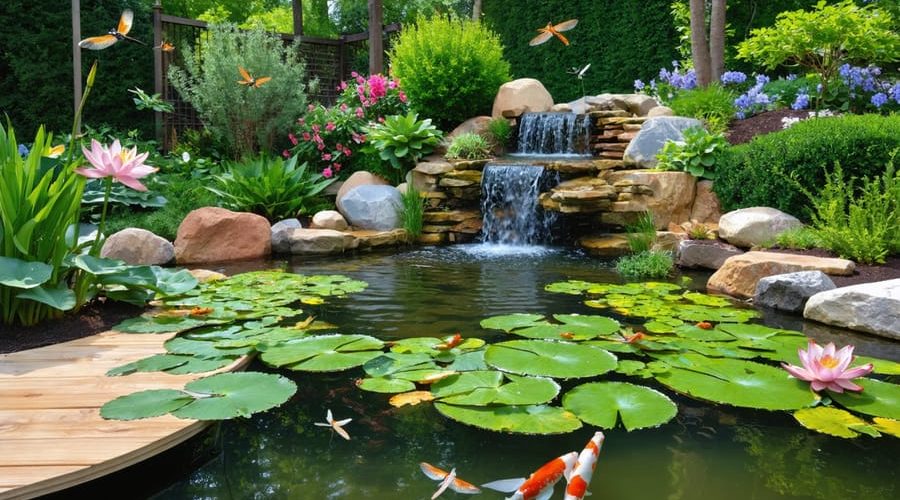
Transform Your Backyard Into a Living Ecosystem With These Sustainable Koi Pond Designs
Transform your backyard into a mesmerizing koi paradise by designing a pond that balances natural beauty with practical functionality. Strategic depth zones, ranging from 2 to 6 feet, create essential fish sanctuaries while supporting a thriving ecosystem. Incorporate gently sloping walls and multiple levels to accommodate diverse aquatic plants, which not only enhance visual appeal but also provide natural filtration and shelter for your koi. Consider positioning your pond where it receives morning sun and afternoon shade, protecting fish from extreme temperatures while reducing algae growth. Modern pond designs seamlessly blend Japanese aesthetics with eco-friendly features like natural bio-filters, waterfalls for oxygenation, and native marginal plants that create stunning reflections on the water’s surface. Whether you’re planning an intimate 500-gallon haven or an expansive 5,000-gallon water garden, these design principles ensure your koi pond becomes both a sustainable aquatic habitat and a captivating focal point in your landscape.
Natural Filtration Systems That Save Energy
Constructed Wetland Zones
Adding a constructed wetland zone to your koi pond creates a natural filtration system that’s both beautiful and functional. These planted areas work like nature’s kidneys, cleaning the water while providing a haven for beneficial wildlife. The key is to create different depth zones that accommodate various aquatic plants.
Start by designing a shallow marsh area around the pond’s edge, roughly 2-6 inches deep. This zone is perfect for marginal plants like iris, rushes, and cattails. Next, create a slightly deeper area (6-12 inches) for plants like water lilies and lotus. These plants not only filter the water but also provide shade for your koi.
For maximum filtration, incorporate a dedicated bog filter area where water flows through densely planted gravel beds. Plants like cardinal flower, pickerelweed, and sweet flag excel at removing excess nutrients. Position this zone where water enters the pond to pre-filter incoming water.
To establish your wetland zone, use aquatic plant soil in mesh containers and cover with gravel to prevent soil from clouding the water. Space plants about 12 inches apart to allow for growth. Remember to trim plants regularly and remove dead foliage to prevent excess organic matter from accumulating in your pond.
This natural approach reduces maintenance needs while creating a more balanced ecosystem for your koi. Plus, the added plant life attracts beautiful dragonflies, butterflies, and birds, making your pond a true backyard wildlife sanctuary.
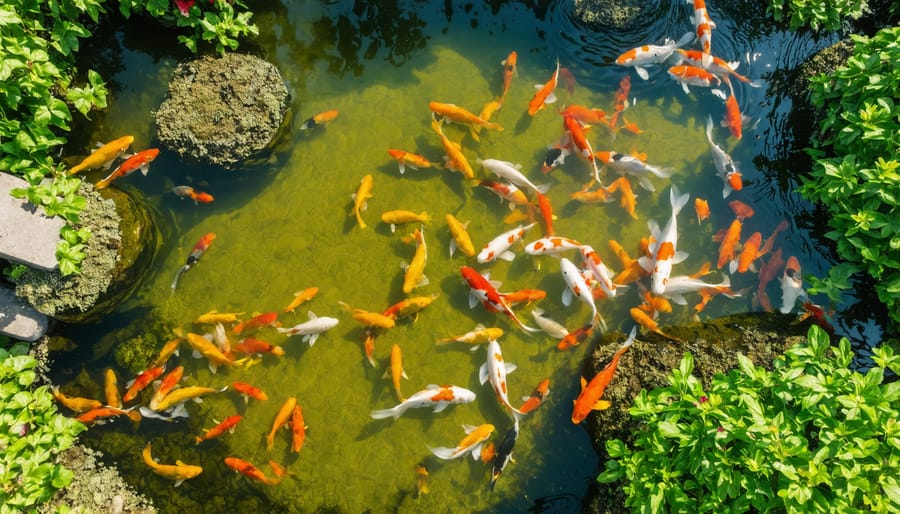
Solar-Powered Solutions
Going green with your koi pond not only helps the environment but can also reduce your energy bills significantly. Solar-powered solutions are becoming increasingly popular among pond enthusiasts, offering reliable and sustainable ways to keep your pond healthy and functioning.
The heart of a solar-powered koi pond system is the solar pump. These efficient devices connect to solar panels that can be discreetly positioned in your garden to capture maximum sunlight. Modern solar pumps are powerful enough to circulate water effectively, even on cloudy days, thanks to improved technology and battery storage options.
For optimal performance, consider installing a hybrid solar system that can automatically switch to grid power during extended periods of low sunlight. This ensures your koi always have proper water circulation and oxygen levels. Many solar pump kits come with built-in filters, making installation straightforward for DIY enthusiasts.
The initial setup cost might be higher than traditional electric systems, but the long-term savings are substantial. Most solar-powered pond equipment pays for itself within two to three years through reduced electricity costs. Plus, many regions offer tax incentives for installing solar equipment, making it even more cost-effective.
When selecting solar equipment, choose components rated for your pond’s size and depth. A typical 1000-gallon koi pond usually requires a 120-watt solar panel system to power both filtration and aeration needs effectively.
Remember to position your solar panels where they’ll receive maximum sunlight exposure, typically facing south in the Northern Hemisphere, and keep them clean for optimal performance.
Water-Smart Design Elements
Strategic Depth Zones
Creating varied depths in your koi pond isn’t just about aesthetics – it’s essential for the health and happiness of your aquatic friends. Understanding these crucial pond zones will help you create a thriving ecosystem that works year-round.
A well-designed koi pond typically features three main depth zones. The shallow zone, ranging from 1-2 feet deep, serves as a transition area and home to marginal plants. The mid-depth zone, around 3-4 feet, provides space for swimming and helps to maintain optimal temperatures throughout the year. The deepest zone should be at least 4-6 feet, offering your koi a safe retreat during extreme weather and protection from predators.
These varying depths create natural temperature layers that help regulate your pond’s environment. During summer, koi can escape the heat by swimming to cooler bottom waters. In winter, the deeper areas prevent the pond from freezing solid, providing a safe haven for your fish.
When planning your depth zones, create gentle slopes rather than sharp drops. This makes maintenance easier and helps prevent debris accumulation in corners. A good rule of thumb is to make your deepest point about one-third of the pond’s total surface area. Remember to include ledges or shelves along the edges for plants and easy access during maintenance.
For smaller gardens, you can still incorporate different depths by creating distinct zones, just on a smaller scale. The key is maintaining proper proportions while ensuring each zone serves its intended purpose.
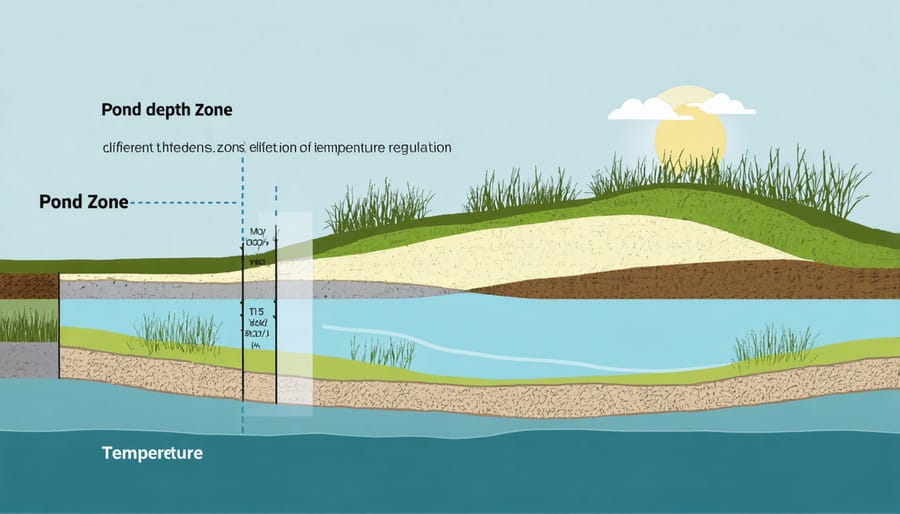
Rainwater Harvesting Integration
Integrating rainwater collection systems into your koi pond design isn’t just eco-friendly – it’s a smart way to maintain water quality and reduce utility costs. By capturing rain from your roof or other surfaces, you can naturally replenish your pond while providing your koi with soft, chemical-free water they’ll love.
Start by installing gutters and downspouts that direct rainwater into a collection barrel or storage tank. These containers should include a first-flush diverter to prevent debris and initial runoff from entering your pond. Consider positioning multiple collection points around your property to maximize water harvesting potential.
For optimal integration, create a gravity-fed system where stored rainwater can naturally flow into your pond when needed. Install a simple valve system to control water flow, and add a basic filtration screen to catch any remaining particles. If your storage is at ground level, a small pump can help transfer water to your pond.
During heavy rainfall, use overflow pipes to prevent flooding and direct excess water away from your pond. This helps maintain stable water levels and protects your koi from stress. You can also incorporate a rain garden near your pond to naturally filter runoff before it enters the system.
Remember to position your collection tanks in a shaded area to prevent algae growth and consider disguising them with attractive landscaping or wooden screens. This way, your rainwater system becomes both functional and aesthetically pleasing, enhancing your overall pond design while supporting sustainable water management.
Native Plant Selection for Pond Balance
Floating Gardens
Floating gardens add a magical touch to your koi pond while providing essential shade and shelter for your fish. These natural additions create stunning visual interest and help maintain a healthy ecosystem. By incorporating floating plants like water lilies, water hyacinths, and lotus flowers, you’ll create natural hiding spots that make your koi feel secure while reducing algae growth by limiting sunlight penetration.
Start with a mix of different floating plants to achieve various heights and textures. Water lilies are perfect centerpieces, with their broad leaves offering ample shade and beautiful blooms adding splashes of color. Surround these with smaller floating plants like duckweed or water lettuce to fill gaps and create a more natural appearance.
Consider placing floating planters strategically around your pond, ensuring they cover about 40-60% of the surface area. This coverage provides enough shade without overcrowding the pond. For added interest, try incorporating miniature floating islands made from natural materials like cork or bamboo, which can host small marginal plants.
Remember to maintain your floating garden by regularly trimming excess growth and removing dead foliage. During winter, some floating plants may need to be moved indoors or treated as annuals, depending on your climate. This seasonal change allows you to refresh your design annually while maintaining the perfect balance between beauty and functionality.
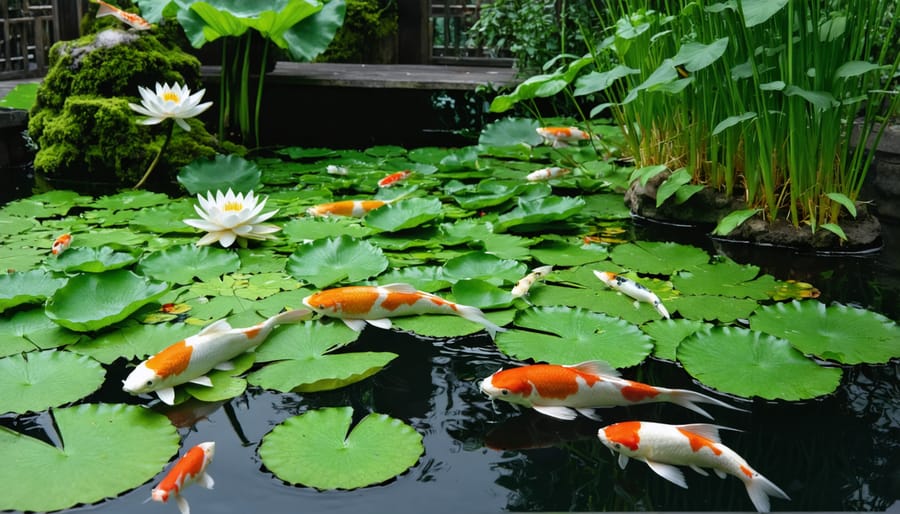
Edge Planting Strategies
Creating a natural border around your koi pond not only enhances its beauty but also serves crucial practical purposes. Strategic edge planting helps prevent soil erosion, filters harmful runoff before it enters your pond, and creates a seamless transition between your water feature and the surrounding landscape.
Start by incorporating a mix of marginal plants along the pond’s edge. Plants like iris, rushes, and sedges develop strong root systems that hold soil in place while adding visual interest. Place these plants in shallow shelves or pockets built into your pond’s perimeter, ensuring they’re secured in aquatic planting baskets filled with aquatic soil.
For effective runoff filtration, create a graduated plant buffer zone extending 2-3 feet from the pond’s edge. Plant taller species at the back and shorter ones near the water. Consider hardy options like cattails, sweet flag, and marsh marigolds, which naturally filter pollutants and excess nutrients from water.
Rock borders can complement your plantings while providing additional erosion control. Layer different-sized rocks, starting with larger ones at the bottom and graduating to smaller stones on top. This creates natural-looking edges while stabilizing the soil.
Don’t forget to include some overhanging plants that provide shade and shelter for your koi. Ornamental grasses and trailing plants like creeping Jenny can soften hard edges while offering fish protection from predators.
Smart Materials and Construction Methods
Eco-Friendly Liner Options
When it comes to creating an environmentally conscious koi pond, choosing the right liner material is crucial. Modern eco-friendly options not only protect our environment but also provide excellent durability for your pond. EPDM rubber liners made from recycled materials are becoming increasingly popular, offering both sustainability and a 20+ year lifespan when properly installed.
Bentonite clay presents a natural alternative that’s gaining traction among environmentally conscious pond owners. This swelling clay creates a watertight seal when compacted and hydrated, essentially forming a natural pond bottom. While it requires more initial labor, it’s completely biodegradable and integrates seamlessly with the surrounding ecosystem.
RPE (Reinforced Polyethylene) liners manufactured from recycled plastics offer another sustainable choice. These liners are typically thinner than traditional options but don’t compromise on strength, making them easier to work with during installation. Some manufacturers now offer RPE liners with UV-resistant properties derived from natural minerals rather than synthetic additives.
For installation, consider using geotextile underlayment made from recycled fibers to protect your liner. The sand-free installation method, which uses these protective layers instead of sand, reduces resource consumption and transportation costs. Remember to properly grade the pond bottom and remove sharp objects before laying any liner to ensure maximum longevity and prevent the need for premature replacement.
Natural Stone Selection
Natural stone selection can make or break your koi pond’s aesthetic appeal while serving crucial functional purposes. Local stones are not only cost-effective but also blend seamlessly with your landscape’s natural environment. When selecting stones, look for a mix of sizes – from large boulders for dramatic focal points to smaller rocks for edging and detail work.
For the pond’s edge, opt for flat stones that slightly overhang the water. This creates natural-looking hiding spots for your koi and helps conceal pond liner edges. Round river rocks work beautifully for creating gentle slopes and transitions between different areas of your pond.
Consider using slate or limestone for waterfalls and streams – these stones naturally channel water in attractive patterns and are relatively easy to stack. However, avoid using soft stones like sandstone, which can deteriorate over time and affect water quality.
Remember to thoroughly clean all stones before placement, removing any dirt or debris that could impact your pond’s ecosystem. Position larger stones first, creating a stable foundation, then work your way up to smaller decorative pieces. For a more natural look, bury the bottom third of larger stones in the ground.
When arranging stones, think about creating multiple levels and varying depths. This not only adds visual interest but also provides different zones for your koi to explore and rest. Aim to position stones in odd-numbered groupings, as this tends to look more natural than symmetrical arrangements.
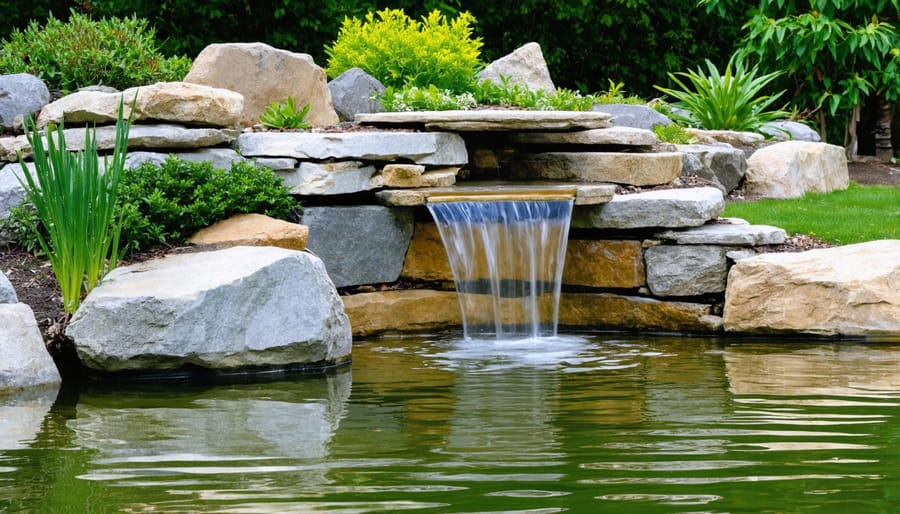
Maintenance-Reducing Features
A well-designed koi pond can significantly reduce your maintenance workload while keeping your fish healthy and happy. Start with a bottom drain system, which automatically removes settling debris and waste, eliminating the need for frequent manual cleaning. Pair this with a properly sized skimmer to catch floating debris before it sinks.
Install an efficient filtration system that includes both mechanical and biological filtration components. A good rule of thumb is to choose a filter rated for at least 1.5 times your pond’s volume. This oversizing helps maintain cleaner water for longer periods between maintenance sessions.
Strategic plant placement can also minimize maintenance needs. Include submerged plants like hornwort or anacharis, which naturally filter the water and compete with algae for nutrients. Position marginal plants around the pond’s edge to catch debris before it enters the water and provide natural filtration.
Consider incorporating an automatic top-off system to maintain consistent water levels. This prevents stress on your pump system and reduces the time you spend monitoring and adjusting water levels. UV clarifiers can help control algae growth, reducing the frequency of green water problems.
Design your pond with easy access points for maintenance when needed. Include shallow shelves or stepping stones that allow you to reach all areas of the pond safely. Choose rounded corners over sharp angles, as they’re easier to clean and promote better water circulation.
Install reliable pond lighting on timers to eliminate daily adjustments, and consider adding an automatic fish feeder for consistent feeding schedules. A variable-speed pump can adjust water flow based on seasonal needs while reducing energy consumption.
Remember to incorporate a quarantine area in your design. This separate space helps manage fish health more effectively and reduces the risk of introducing diseases to your main pond, saving time and effort in the long run.
Creating a sustainable koi pond isn’t just about following trends – it’s about harmonizing with nature while creating a beautiful, thriving ecosystem that will bring joy for years to come. Throughout this guide, we’ve explored various eco-friendly design principles that not only benefit the environment but also create healthier environments for your koi and reduce long-term maintenance needs.
Remember that sustainable pond design starts with careful planning: choosing the right location, implementing natural filtration systems, and selecting native plants that support local biodiversity. By incorporating features like rain catchment systems, solar-powered pumps, and natural barriers, you’re not just creating a pond – you’re establishing a self-sustaining water garden that works with nature rather than against it.
The key to success lies in balance. Whether you’re working with a small corner of your backyard or designing a grand water feature, the principles remain the same: minimize resource consumption, maximize natural processes, and create habitats that support both your koi and local wildlife.
As you begin your pond project, don’t feel pressured to implement every sustainable feature at once. Start with the basics and gradually enhance your pond’s eco-friendly elements over time. Focus on creating proper water circulation, establishing beneficial bacteria colonies, and maintaining appropriate plant coverage before moving on to more advanced features.
Remember that every sustainable choice you make, no matter how small, contributes to the health of your pond ecosystem and the broader environment. Your koi pond can be more than just a beautiful feature in your garden – it can be a testament to responsible stewardship and sustainable living.
